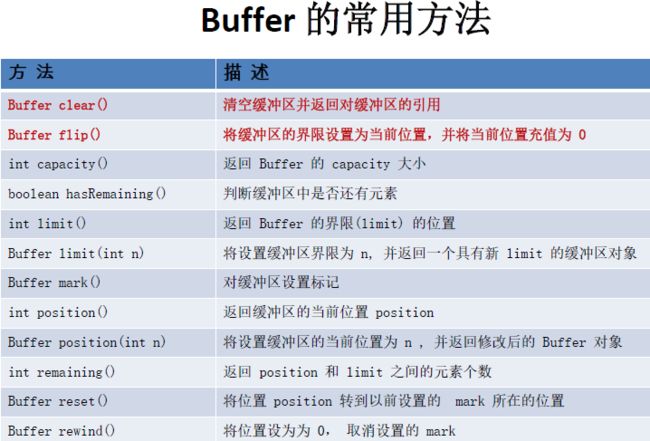JAVA 1.8 中文文档下载地址
提取码:
o425
1. IO和NIO的区别
Java IO和NIO的区别:
| IO | NIO |
|---|---|
| 面向流 | 面向缓冲区 |
| 阻塞IO | 非阻塞IO |
| IO没有选择器 | 选择器(Selector) |
注:阻塞和非阻塞、Selector选择器仅限于网络IO。
1.1 面向流和面向Buffer
JavaIO和NIO最大的区别是IO是面向流(Stream),NIO是面向缓存区(buffer)。
在以往的JavaIO模型中,我们面向的是流,对于流来说,数据的传输的单向的。对于管道来说,数据的传输时双向的。
1.2 阻塞和非阻塞
阻塞和非阻塞是仅限于网络IO来说的,而且针对的是操作IO后得到的返回结果而言的。
阻塞:调用IO后,一直等待,直到文件复制到用户空间;
非阻塞:调用IO后,立刻返回结果;
JAVA NIO实际上采用的是多路复用IO模型。当调用IO后,用户线程会被select函数阻塞(select函数会在内核中不断轮询状态)。
1.3 选择器
Selector一般称为“选择器”,也可以理解为多路复用器,它是JAVA NIO核心组件中的一个,用于检查一个或多个NIO Channel的状态是否处于可读可写。
使用Selector的好处在于:使用更少的线程就可以处理通道,相比于使用多个线程,避免了线程上下文切换带来的开销。
2.NIO的结构
NIO本身是基于事件驱动思想来设计的。本质上是想解决BIO(阻塞IO)和大并发的问题。
首先我们看一下NIO的结构。
NIO主要有三个核心部分组成:
- Buffer缓冲区
- Channel 管道
- Selector 选择器
2.1 管道(Channel)和缓冲区(Buffer)概述
在以往的Java IO模型中,我们面向的是流。而流是单向的,所以我们有了输入流和输出流。每次在流里面读取一个或者多个字节。
而NIO中不是以流的方式来处理数据的,而是buffer缓冲区加Channel管道配合使用处理数据的。
Channel通道:用来传输数据,作用是打开到IO设备(例如:文件、套接字)的连接。
Buffer缓冲区:用来存储数据,并对数据进行处理。
- 对于流来说,数据的传输是单向的;
- 对于管道来说,数据的传输是双向的;
2.2 Buffer缓冲区详解
对于Buffer来说,就像一个数组,可以保存多个相同类型的数据。
除boolean外,其他基本类型的封装类型均有自己的Buffer类。我们可以使用static XxxBuffer allocate(int capactity)创建一个容量为capacity的XxxBuffer对象。下面是Buffer子类:
- ByteBuffer
- CharBuffer
- ShortBuffer
- IntBuffer
- LongBuffer
- FloatBuffer
- DoubleBuffer
我们想了解Buffer缓冲区,那么需要了解一下他的属性。
// Invariants: mark <= position <= limit <= capacity
private int mark = -1; //缓冲区标记位置
private int position = 0; //缓冲区当前位置
private int limit; //缓冲区可用容量
private int capacity; //缓存区总容量
- 容量(capacity) :(最大位置)表示Buffer最大数据容量,缓冲区容量不能为负,并且创建后不能更改。
- 限制(limit):(可用位置)第一个不应该读取或写入的数据的索引,即位于limit 后的数据不可读写。缓冲区的限制不能为负,并且不能大于其容量。
- 位置(position):(当前位置)下一个要读取或写入的数据的索引。缓冲区的位置不能为负,并且不能大于其限制。
- 标记(mark)与重置(reset):(标记位置)标记是一个索引,通过Buffer 中的mark() 方法指定Buffer 中一个特定的position,之后可以通过调用reset() 方法恢复到这个position。
参数之间关系:0<=mark <= position <= limit <= capacity
直接与非直接缓冲区的区别
1.非直接缓冲区:
- 将内存建立在JVM中(传统IO也是这种)。
- 通过
allocate方法得到。 - 小数据选用。
- 通过
isDirect方法进行判断。
2.直接缓冲区:
- 2.1.将内存直接建立在操作系统的物理内存中,可以提高效率。但是消耗较大,失去对缓冲区管理权。
- 2.2.通过
allocateDirect方法的得到。 - 2.3.超大数据时。
- 2.4 使用了
直接内存,避免了Native堆和JVM堆之间来回复制数据,在一定程度上提高了性能。
关于直接缓存的知识,可以在JVM那点事-JVM内存结构了解。关于如何选择可以缓冲区在JVM那点事-内存溢出如何处理(2)了解。关键还是要看服务器的内存大小。
利用通道完成文件的复制(非直接缓冲区)
@Test
public void nio1() throws IOException {
long start = System.currentTimeMillis();
FileInputStream fis = null;
FileOutputStream fos = null;
//①获取通道
FileChannel inChannel = null;
FileChannel outChannel = null;
try {
fis = new FileInputStream("src\\main\\resources\\aa2.png");
fos = new FileOutputStream("src\\main\\resources\\112.png");
inChannel = fis.getChannel();
outChannel = fos.getChannel();
//②分配指定大小的缓冲区
ByteBuffer buf = ByteBuffer.allocate(1024);
//③将通道中的数据存入缓冲区中
while (inChannel.read(buf) != -1) {
buf.flip(); //切换读取数据的模式
//④将缓冲区中的数据写入通道中
outChannel.write(buf);
buf.clear(); //清空缓冲区
}
} finally {
if (outChannel != null) {
outChannel.close();
}
if (inChannel != null) {
inChannel.close();
}
if (fos != null) {
fos.close();
}
if (fis != null) {
fis.close();
}
}
long end = System.currentTimeMillis();
System.out.println("耗费时间为:" + (end - start));
}
使用直接缓冲区完成文件的复制(内存映射文件)
@Test
public void test2() throws IOException{//2127-1902-1777
long start = System.currentTimeMillis();
FileChannel inChannel = FileChannel.open(Paths.get("d:/1.mkv"), StandardOpenOption.READ);
FileChannel outChannel = FileChannel.open(Paths.get("d:/2.mkv"), StandardOpenOption.WRITE,
StandardOpenOption.READ, StandardOpenOption.CREATE);
//内存映射文件
MappedByteBuffer inMappedBuf = inChannel.map(MapMode.READ_ONLY, 0, inChannel.size());
MappedByteBuffer outMappedBuf = outChannel.map(MapMode.READ_WRITE, 0, inChannel.size());
//直接对缓冲区进行数据的读写操作
byte[] dst = new byte[inMappedBuf.limit()];
inMappedBuf.get(dst);
outMappedBuf.put(dst);
inChannel.close();
outChannel.close();
long end = System.currentTimeMillis();
System.out.println("耗费时间为:" + (end - start));
}
通道之间的数据传输(直接缓冲区):
@Test
public void test3() throws IOException{
FileChannel inChannel = FileChannel.open(Paths.get("d:/1.mkv"), StandardOpenOption.READ);
FileChannel outChannel = FileChannel.open(Paths.get("d:/2.mkv"), StandardOpenOption.WRITE,
StandardOpenOption.READ, StandardOpenOption.CREATE);
// inChannel.transferTo(0, inChannel.size(), outChannel);
outChannel.transferFrom(inChannel, 0, inChannel.size());
inChannel.close();
outChannel.close();
}
2.3 Channel通道详解
Channel类似于流,但是Channel本身不能直接访问数据,Channel只能与Buffer进行交互,进行传输数据。
Java 为Channel 接口提供的最主要实现类如下:
- FileChannel:用于读取、写入、映射和操作文件的通道。
- DatagramChannel:通过
UDP读写网络中的数据通道。 - SocketChannel:通过
TCP读写网络中的数据。 - ServerSocketChannel:可以监听新进来的TCP 连接,对每一个新进来的连接都会创建一个
SocketChannel。
获取通道的三种方法:
- 获取通道的一种方式是对支持通道的对象调用
getChannel()方法。支持通道的类如下:
FileInputStream
FileOutputStream
RandomAccessFile
DatagramSocket
Socket
ServerSocket - 获取通道的其他方式是使用Files 类的静态方法
newByteChannel()获取字节通道。 - 通过通道的静态方法
open()打开并返回指定通道。
通道内数据传输:
文件001-->通道A-->缓存区-->通道B-->文件002
缓冲区通过通道A读取文件001的数据;
然后通过通道B写入文件002中。
//③将通道中的数据存入缓冲区中
while(inChannel.read(buf) != -1){
buf.flip(); //切换读取数据的模式(当前位置指向0)
//④将缓冲区中的数据写入通道中
outChannel.write(buf);
buf.clear(); //可用位置+当前位置都指向0
}
分散(Scatter)和聚集:
聚集写入(Gathering Writes)是指将多个Buffer中的数据“聚集”到Channel。
注意:按照缓冲区的顺序,写入position 和limit之间的数据到Channel 。
//分散和聚集
@Test
public void test4() throws IOException{
RandomAccessFile raf1 = new RandomAccessFile("1.txt", "rw");
//1. 获取通道
FileChannel channel1 = raf1.getChannel();
//2. 分配指定大小的缓冲区
ByteBuffer buf1 = ByteBuffer.allocate(100);
ByteBuffer buf2 = ByteBuffer.allocate(1024);
//3. 分散读取
ByteBuffer[] bufs = {buf1, buf2};
channel1.read(bufs);
for (ByteBuffer byteBuffer : bufs) {
//每读满一个buffer,当前位置(position)指向0
byteBuffer.flip();
}
System.out.println(new String(bufs[0].array(), 0, bufs[0].limit()));
System.out.println("-----------------");
System.out.println(new String(bufs[1].array(), 0, bufs[1].limit()));
//4. 聚集写入
RandomAccessFile raf2 = new RandomAccessFile("2.txt", "rw");
FileChannel channel2 = raf2.getChannel();
channel2.write(bufs);
}
编码和解码
//字符集
@Test
public void test6() throws IOException{
Charset cs1 = Charset.forName("GBK");
//获取编码器
CharsetEncoder ce = cs1.newEncoder();
//获取解码器
CharsetDecoder cd = cs1.newDecoder();
CharBuffer cBuf = CharBuffer.allocate(1024);
cBuf.put("我是GBK!");
cBuf.flip();
//对缓冲区进行--编码
ByteBuffer bBuf = ce.encode(cBuf);
//对缓冲区进行--解码
bBuf.flip();
CharBuffer cBuf2 = cd.decode(bBuf);
System.out.println(cBuf2.toString());
System.out.println("------------------------------------------------------");
Charset cs2 = Charset.forName("GBK");
bBuf.flip();
CharBuffer cBuf3 = cs2.decode(bBuf);
System.out.println(cBuf3.toString());
}
Channel的API
文章推荐
为什么说Java NIO 是非阻塞的?
相关文章
IO学习(1)Java-BIO体系学习
IO学习(2)-各种IO模型
IO学习(3)— IO和NIO的区别
IO学习(4)— select、poll、epoll的区别


